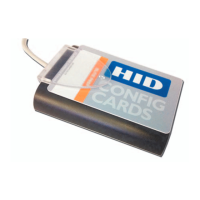July 2017 PLT-01067, Version: A.7
Overview Page 1-5
Things to know about credential credits:
Each credit token type is managed by its respective credit counter.
Credit top up messages are delivered in a secure SNMP message that is targeted for a specific
device by diversifying the keys with the device Engine ID.
Credit top up messages can be loaded only once.
A cap (10,000 credits) is placed on the number of credits that can be ordered at a time. This is
to limit the monetary value that can be loaded into a single encoder device which can be lost or
destroyed.
1.1.7 Formats
The iCLASS SE Encoder includes a format interpreter capable of parsing all open and custom
formats developed and maintained by HID Global.
Format fields are presented to you in the desktop UI for the purpose of assigning data to each field.
Formats must be ordered from Customer Service. Most formats are custom to a specific OEM or
end user, and are not freely distributed.
The H10301 (SIA Wiegand 26-bit) is the default format delivered with the desktop application.
1.1.8 Plugin Architecture
The iCLASS SE Encoder includes a plugin architecture which makes it highly configurable with
minimal maintenance and few releases. There are two types of plugins:
Technology
Configuration
Technology plugins are a packaged bundle that includes an applet which is loaded to the encoder
device and a UI plugin for the desktop application that is customized for the associated applet.
Applets are small C# applications designed to run on the .NET framework that is native to the
encoder device. These applets manage the interface to the credential and provide an API to the
desktop application. Applets can be tailored for a specific use case.
The UI plugin manages the interface to the encoder device and provides you with inputs and
information specific to the applet loaded on the device. For example, each technology applet
comes with a unique set of wizard pages gathering user input for work order creation.
Configuration plugins expose a UI for gathering inputs and creating reader configuration cards.
Reader configuration plugins are released as groups that organize parameters.
Things to know about plugins:
Each applet is digitally signed by a key managed by HID Global and known by all encoder
devices (global key). This identifies the applet as Genuine HID. Only Genuine HID plugins are
recognized by the encoder device.
Initially, one applet/plugin is created for each of the four supported technologies (iCLASS,
MIFARE Classic, MIFARE DESFire EV1, HID Prox, and Seos).
Custom plugins can be created on a Custom Product Opportunity (CPO) basis.

